|
Yoga Meditation
is the art and science of systematically observing, accepting,
understanding, and training each of the levels of our being,
such that we may coordinate and integrate those aspects of
ourselves, and dwell in the direct experience of the center of
consciousness. (There is a 16-page description of traditional Yoga
Meditation, which explains the process in practical terms, and
simple language.)
Yoga Meditation is not actually
a separate aspect of Yoga, due to the fact that traditional Yoga virtually
is
meditation. However, the phrase Yoga Meditation can be used
here to discriminate between traditional Yoga Meditation and the now popular
belief that Yoga is about physical postures. Yoga or Yoga
Meditation is a complete process unto itself, only a small,
though useful part of which relates to the physical body. (See
the article Modern Yoga versus
Traditional
Yoga)
|
|
|
|
3 Stages of Awareness |
|
1) Awareness Manifests
Outward to the World |
|
Yoga,
Sankhya, Vedanta, and Tantra view the human as manifesting
outward step-by-step, whereby the subtler consciousness projects
evermore outward, and then gradually forgets those subtler
levels. Genesis also
explains this outward movement when seen through the eye
of the Yogi or mystic. (Sankhya,
Vedanta,
Tantra,
Adhyasa)
|
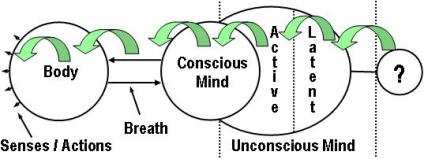 |
|
|
2) In
Yoga Each Aspect is Trained |
|
Yoga is
complete unto itself. In Yoga, each level of our being
is trained independently, while also being trained to
flow together. The systematic processes deal one-by-one with our
actions in the world, senses, body, breath, and and
both the conscious and unconscious aspects of mind.
|
|
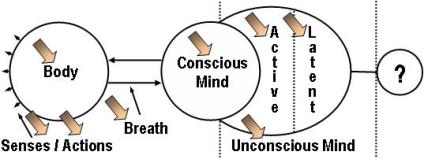 |
|
|
3) Awareness Recedes to the State of Yoga* |
|
Yoga or "Union" is
attained by first training, balancing, and purifying
each of the aspects of our being individually, and then systematically receding
attention inward through those levels, expanding so as
to experience the state of
Union, Yoga, Samadhi, or Turiya.
|
|
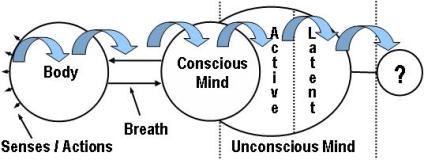 |
|
|
Individual Stages of Yoga
Practice |
|
Body and Breath |
|
The Yoga
practices with Body and Breath bring health benefits and
balance in life. However, many
people stop at the Breath, and are unwilling to explore
or train the Mind. It is like building a wall between
the Yogic stages of Breath and Mind. Some sincere seekers delay out of fear.
Others incorrectly believe that Yoga is only about
physical fitness. The key for the sincere seeker of the
highest joy of Yoga is to be
gentle and loving towards yourself, and persist with all
levels of Yoga, including directly dealing with the Mind
itself.
|
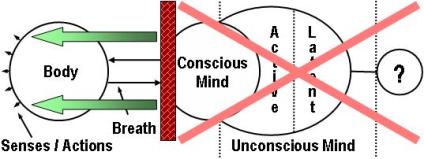 |
|
|
Conscious
Mind |
|
Mindfulness of the emotional and mental processes of the
Conscious mind is very stabilizing. In Yoga, this
includes meditation and contemplation on attitudes of
friendliness, lovingness, compassion, and acceptance. It
includes cultivating non-harming, truthfulness,
non-stealing, remembering of truth, and
non-possessiveness. However, many stop at this
level of mind, and effectively build a wall between the
Conscious and Unconscious, not willing to explore the
depths of the Unconscious. Many
get stuck here by thinking the goal of meditation is
only a calm mind. For Union, Yoga, Samadhi, or Turiya,
the streams of thoughts in the Active Unconscious mind need to be encountered, explored, and
only then transcended.
|
|
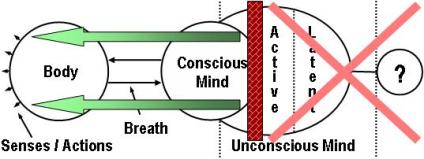 |
|
|
Active Unconscious |
|
By
allowing the Active Unconscious to come forward and be
witnessed in a neutral way, the thought patterns colored
with intense attraction and aversion gradually weaken,
allowing a greater peace and freedom of mind. This is
one of the most direct ways to deal with the purifying,
centering, or balancing of troublesome thoughts.
However, few go
beyond the boundary between the Active Unconscious and
the Latent Unconscious. The Active Unconscious has alluring visions
and sounds. Only the most dedicated Yogis are willing to
completely transcend sensory experience of both external
and internal objects, and to pursue the
formless Latent level out of which the Active arises.
|
|
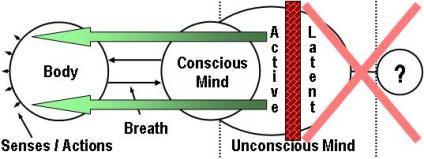 |
|
|
Latent
Unconscious |
|
To be
fully aware of the Latent Unconscious is a very deep
state, and an aspect of advanced meditation
(Authentic Yoga Nidra
reaches this Latent Unconscious level with practice). It
is underneath, beyond, or prior to the pictures and
words of the Active Unconscious. It is the ground out of
which those emerge. All sensory experiences such as
sights and sounds have been left behind, whether of
external worldly objects or inner images. To consciously
rest in the awareness of the Latent Unconscious is to
be filled with bliss. However, there
comes a point where individuation itself is the final
wall, and even the bliss needs to be transcended. Even for the experienced practitioner this can be
a great obstacle. It is beyond the mind in the
conventional sense of mind, so the mind can no longer be
an aid. Body and breath cannot help. It is only
surrender that finally helps.
|
|
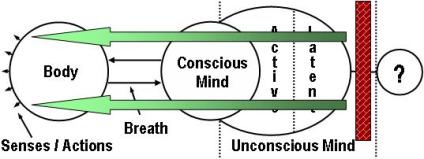 |
|
|
Realization |
|
Whether
you call it Grace, God, Guru, Shaktipat, or some other
name, the greatest help of all finally comes from within to remove the final barrier
of ignorance (Avidya).
This final stage is a process that has been called
piercing the pearl of wisdom (Bindu). A Yogi does not debate
whether the Realization is called Yoga, Self, Atman, Soul,
or God, etc., but rather, lives "in" the world while not being
"of" the world.
|
|
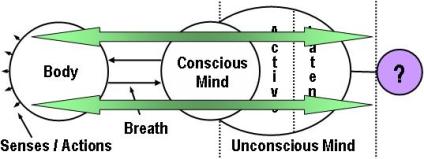 |
|
|
"In" the World
-- Not "of" the World |
|
The
Realized Yogi lives like a lotus flower. The lotus is
both "in" the world, yet not "of" the world. It grows in the
soil and water of the world, yet rises above it at the same
time. It goes outward (Adhyasa), but is not blinded by Avidya or Ignorance
of its true nature. (Avidya-Adhyasa)
|
|
 |
|
In the
traditional Yoga Meditation of the Himalayan tradition, one systematically works with senses,
body, breath, the various levels of mind, and then goes beyond,
to the center of consciousness. The science of Yoga Meditation
as taught by the Himalayan sages is already a whole, complete
science that has been torn into smaller pieces over time.
Individual parts have sometimes (unfortunately) been cut out
from the whole of traditional Yoga Meditation, given separate names, and
then taught as unique systems of meditation. The perspective of
Yoga Meditation on the SwamiJ.com site is that it is not a
pasting together of disparate Yogas, but an already unified
whole that we might call traditional Yoga Meditation, or simply Yoga.
Yoga Meditation of the
Himalayan tradition is holistic in that it not only systematically
deals with all levels individually, and then integrates them
with one another, it also involves a broad range
of practices, including meditation,
contemplation, prayer, and mantra, as well as the
preparatory practices leading up to these. Traditional Yoga Meditation also
explores all of the levels of reality and self-construction,
including the:
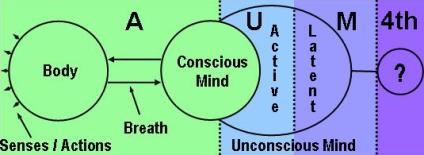
The root meaning of Yoga
Meditation lies in the meaning of the word Yoga itself, which
comes from "yuj" which means "to join," to bring together the
aspects of yourself that were never divided in the first place.
The Yoga Sutras of Patanjali is a
primary source of learning the practices of traditional Yoga Meditation. The
finer points of Yoga Meditation are described and taught
face-to-face, as it is an oral tradition. Hopefully, the many
articles on SwamiJ.com will enhance your understanding and
practicing traditional Yoga Meditation. There includes a succinct outline of
Beginning, Intermediate and Advanced Yoga Meditation.
In the Himalayan tradition,
Yoga Meditation is not limited to just the Yoga Sutras, but also
includes Vedanta and internal Tantra, while also acknowledging
that the practices are also contained in many other sources (See
the article, Yoga, Vedanta,
Tantra). The teachers of the Himalayan tradition may
emphasize or draw on some of these (or other) sources more or
less than others, matching the teachings with the student.
Traditional Yoga
Meditation in the tradition of the Himalayan masters also involves the process of
Kundalini Awakening, and this is described in a series of
pages on the site.
Tripura, the
Three Cities: The three streams
of Yoga Meditation, Vedanta, and Tantra include at their core the
principle of the "three cities" or "tripura," seeking to know that
"one" who
lives in those three cities of:
This "one" living
in, or permeating the three cities is the Turiya, or fourth
state in the AUM mantra. In Tantra that "one" is known as Shakti,
or sometimes Maha Tripura Sundari, which means the great,
beautiful one, essence, consciousness, or reality living in the
three cities.
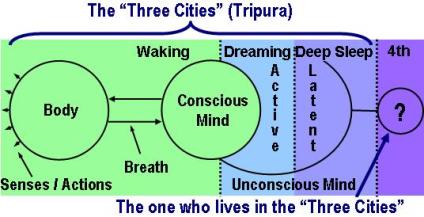
Yoga Meditation
itself is not a
religion, although some of the principles are contained within
the various religions. There are articles on
Mysticism
and Religion on the site, which
should give a good overview of this perspective of traditional Yoga
Meditation.
The many articles on Yoga
Meditation are linked directly on the home page (above), as well
as the Index pages, which are at the top of this, and other
pages. You can easily access those Indexes by clicking on the
little mountain icon at the top of any page on the site.
Please enjoy your visit to the
SwamiJ.com site on Yoga Meditation of the Himalayan Tradition,
and do come back often to visit.
Swami Jnaneshvara
|
| -------
This site is devoted to
presenting the ancient Self-Realization path of
the Tradition of the Himalayan masters
in simple, understandable and beneficial ways, while not compromising
quality or depth. The goal of our sadhana or practices is the highest
Joy that comes from the Realization in direct experience of the
center of consciousness, the Self, the Atman or Purusha, which is
one and the same with the Absolute Reality.
This Self-Realization comes through Yoga meditation of the Yoga
Sutras, the contemplative insight of Advaita Vedanta, and the
intense devotion of Samaya Sri Vidya Tantra, the three of which
complement one another like fingers on a hand.
We employ the classical approaches of Raja, Jnana, Karma, and Bhakti
Yoga, as well as Hatha, Kriya, Kundalini, Laya, Mantra, Nada, Siddha,
and Tantra Yoga. Meditation, contemplation, mantra and prayer
finally converge into a unified force directed towards the final
stage, piercing the pearl of wisdom called bindu, leading to the
Absolute. |